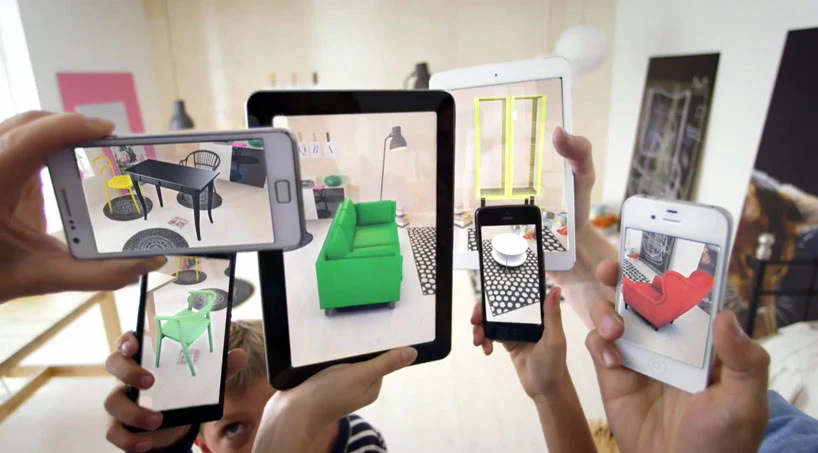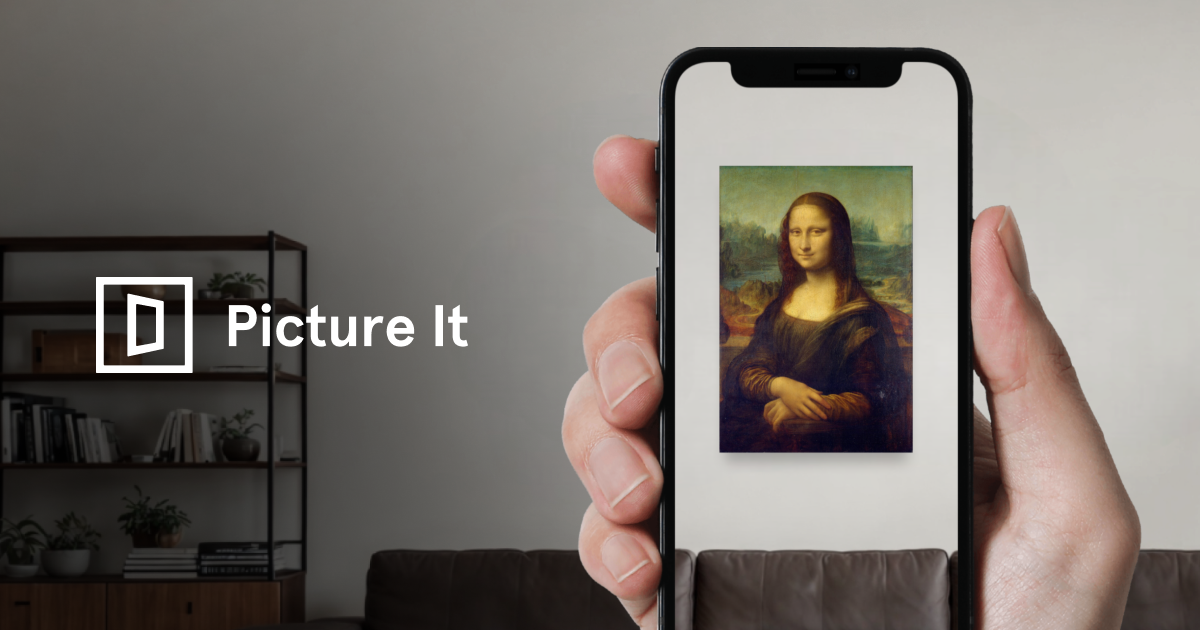Today's online shoppers want more than just static images when browsing products. They crave an experience that mirrors the immersive nature of in-store shopping. Augmented reality (AR) is making this possible across ecommerce categories, with art being a particularly compelling example. This technology is bridging the gap between digital browsing and physical product appreciation, tackling the visualization and confidence issues that often lead to abandoned purchases.

Many online shoppers hesitate to purchase because they can't properly visualize products in their own environment. Imagine buying a striking piece of furniture online, only to find it overwhelms your living room. Or ordering artwork that appears too small and insignificant in your space. These are common frustrations that augmented reality for ecommerce directly addresses.
AR allows customers to virtually "place" products in their own space using smartphones or tablets. This gives shoppers a new level of certainty. The ability to visualize scale, color impact, and stylistic fit in a personal context is changing how we shop for everything from furniture and home decor to artwork and fashion accessories. For art specifically, solutions like Picture It make implementation simple with no need for complex coding or 3D modeling – the platform works directly with standard art images.

Once considered a premium marketing feature, AR technology is now becoming a competitive necessity for online retailers. Leading brands across categories are integrating AR into their ecommerce strategies, understanding its power to enhance the customer journey.
This shift reflects a broader trend. Consumers are becoming more comfortable with immersive technology and increasingly expect it. Retailers that fail to adopt augmented reality for ecommerce risk falling behind competitors who offer these enhanced shopping experiences.
The growth of augmented reality in ecommerce is striking, with visually-driven categories benefiting most from this technology. According to a study by Shopify, products with AR content showed 94% higher conversion rates than products without AR. This shows how valuable the technology is becoming for online retail.
This perception is supported by market trends. AR experiences are significantly more engaging than traditional online shopping. Yet, only a fraction of online retailers currently leverage AR technology. This suggests a huge opportunity for growth. Integrating augmented reality for ecommerce isn't just about improving the customer experience; it's about boosting profitability by reducing returns and building consumer confidence.
Augmented reality for ecommerce tackles the confidence gap that hinders online purchases. When consumers can visualize products in their own space, they feel more confident about buying. This increased confidence leads to higher conversion rates and fewer abandoned carts.
AR lets customers explore how different products look in various settings, lighting conditions, and alongside existing items. This deeper engagement drives sales and fosters stronger connections between brands and consumers. Customers develop a more meaningful relationship with both the products and the retailers.
Product returns are a major challenge for online retailers, impacting logistics, packaging costs, and profitability. Augmented reality for ecommerce offers a solution by addressing the core issues that lead to returns, potentially transforming this business pain point into a competitive advantage.
One of the biggest hurdles in online shopping is the inability to physically experience how products will look in a space. AR tackles this by allowing customers to visualize items in their own environment. Imagine seeing how a large sofa would look in your living room before purchasing, or how a painting would appear on your wall. This visualization reduces uncertainty and empowers informed decisions.
AR also allows for accurate visualization of product dimensions. This is especially helpful for larger items like furniture or statement art pieces, where proper scaling is crucial. AR apps let users "place" virtual products in their homes, eliminating guesswork and reducing the likelihood of returns due to sizing issues.

Another pain point in ecommerce is uncertainty about how colors and textures will appear in different lighting conditions. AR's "try before you buy" functionality solves this for consumers. Customers can preview products in their space at different times of day, with varying light conditions. This interaction builds confidence and reduces buyer's remorse, leading to fewer returns.
This is crucial for products where color accuracy is essential, from furniture and home decor to artwork and fashion. AR lets customers see how colors appear in their specific lighting, ensuring a better match and minimizing dissatisfaction.
Augmented reality for ecommerce addresses several critical challenges faced by online sellers:
These solutions demonstrate how augmented reality for ecommerce directly addresses the core challenges of selling online, delivering tangible business benefits from reducing costly returns to boosting overall customer satisfaction.
The impact of augmented reality on ecommerce sales is significant. When shoppers can visualize products in their own space, they make more confident decisions. Research shows that AR increases conversion rates and decreases return rates across retail categories. The boost in customer satisfaction and average order value underscores AR's power in improving the shopping experience and driving business growth. These positive results show the advantages of using augmented reality in an ecommerce strategy.
Forward-thinking retailers are elevating the customer experience with augmented reality. These sellers recognize AR's potential to go beyond mere functionality. They see it as a potent tool for enhancing the storytelling around products and forging stronger emotional bonds with their clientele. This approach is reshaping the landscape of immersive shopping.
Successful retailers excel at weaving narratives around their products. Augmented reality for ecommerce empowers them to bring these stories to life in the digital sphere. Imagine exploring the intricate details of furniture craftsmanship through an AR experience, or seeing how an artist created a painting. This experience could reveal the production technique and inspiration, offering a deeper understanding of the product's value.
This type of interactive storytelling fosters a connection to the product and underscores the retailer's commitment to innovation. Consumers connect with merchandise on a more emotional level, leading to increased willingness to purchase. This emotional resonance is crucial for driving sales and nurturing enduring relationships with discerning customers.
Leading ecommerce brands are implementing diverse AR strategies. These range from virtual product placement tools to interactive storytelling experiences that reveal the product's origins or creation process. These experiences enhance the customer journey while reinforcing the brand's image of expertise and forward-thinking approach.
These interactive engagements go beyond simple visualization. They might include close-ups showcasing textures and materials, creator commentary, or even interactive elements connected to the product's features and benefits.
Beyond the hype, integrating augmented reality into your ecommerce platform requires a strategic approach. This section offers practical guidance for retailers of all sizes. We'll explore the options, weigh the pros and cons, and provide a roadmap for AR success.
There are two primary paths for integrating AR: third-party solutions and custom development. Each approach has its own set of advantages and disadvantages, impacting both cost and timeline.
Third-Party Solutions: These pre-built platforms offer a faster, more affordable entry point for AR. They often come with user-friendly interfaces and require minimal technical expertise. For art galleries and artists, Picture It stands out as it seamlessly integrates with existing platforms like Shopify without requiring any coding skills or 3D models – it works directly with your existing artwork images. This allows art sellers to quickly add AR previews for their artwork with minimal setup.

Custom Development: This approach offers greater flexibility and control over the AR experience. However, it comes with a significantly higher price tag and longer development timeline, requiring specialized development teams.
To help you choose the best approach for your business, we've compiled a comparison highlighting the key differences between third-party solutions and custom development.
When implementing augmented reality for ecommerce, retailers have two main approaches to consider:
Third-Party Solutions:
Custom Development:
As you can see, third-party solutions like Picture It are ideal for most retailers looking for a quick and cost-effective way to integrate AR. Custom development is better suited for major brands with specific needs and the resources to invest in a more complex solution.
Implementing augmented reality for ecommerce isn't just about choosing the right platform; it's about addressing critical technical considerations. These elements significantly impact the performance and usability of the AR experience.
Mobile Optimization: Since most online shopping occurs on mobile devices, ensuring a smooth, responsive AR experience on smartphones and tablets is crucial. This involves optimizing images and AR interactions for mobile hardware limitations.
High-Quality Product Images: Clear, high-resolution images of your products are essential for a realistic and engaging AR experience. This involves proper photography but pays dividends in showcasing your merchandise accurately. For artwork, Picture It automatically imports product details and images from Shopify, simplifying the process for art sellers. Unlike many AR solutions, Picture It doesn't require creating complex 3D models of your artwork – it works with standard 2D art images, making it particularly accessible for galleries and independent artists.

User Experience (UX): A seamless and intuitive UX is paramount. Complicated interfaces or lengthy loading times can frustrate users and deter them from engaging with the AR feature. Prioritize ease of use and quick loading speeds for optimal customer engagement.
Many AR projects have faced challenges due to common implementation pitfalls. By understanding these potential obstacles, you can proactively address them and ensure a successful AR integration.
Poor Image Quality: Low-resolution or poorly lit product images can lead to an unconvincing AR experience. Ensure professional photography of all products intended for AR display.
Lack of Clear Call to Action: Guide users through the AR experience with clear instructions and prompts. Make it easy for them to understand how to use the feature and encourage interaction.
Ignoring User Feedback: Gather user feedback during and after implementation to identify areas for improvement. This iterative process ensures that the AR experience meets customer needs and drives desired results.
By considering these technical aspects and avoiding common pitfalls, you can ensure your AR implementation enhances the customer experience. For Shopify stores, a plugin like Picture It, with its user-friendly interface, helps sidestep many of these challenges.
Moving beyond vanity metrics, let's explore the real impact of augmented reality on your ecommerce sales. This section examines how successful retailers measure the true business value of their AR strategies, looking at both immediate gains and long-term benefits.
One of the most straightforward ways to measure AR's ROI is to analyze its effect on conversion rates. Augmented reality for ecommerce gives shoppers a better understanding of how products will look in their space, boosting confidence and making a purchase more likely.
AR can also influence average order value (AOV). When customers can visualize products in their own space, they're often more likely to invest in higher-priced items or add complementary products to their cart. Imagine a customer using AR to place a virtual furniture piece in their room. They might then realize they also need matching accessories, increasing the overall purchase value.
The advantages of AR extend beyond immediate sales. By providing a realistic product preview, AR helps reduce the uncertainty that often leads to returns. This means cost savings for retailers on packaging, shipping, and restocking.
Moreover, AR contributes to stronger customer loyalty. Providing engaging and helpful shopping experiences creates a positive brand image and encourages repeat purchases. This translates to higher customer lifetime value, a crucial metric for long-term ecommerce success.
To accurately measure the ROI of augmented reality for ecommerce, retailers should define clear objectives and set related success metrics. These metrics should align with overarching business goals. For example, if a retailer wants to reduce return rates, they should monitor the return rate percentage before and after implementing AR.
It's also important to separate the impact of AR from other optimization efforts. This involves comparing periods before and after AR implementation to accurately attribute improvements to the AR technology.
Ready to transform your online sales with augmented reality? Here's your step-by-step action plan:
The gap between digital and physical shopping experiences is closing rapidly thanks to augmented reality for ecommerce. By implementing these tools on a premiere platform like Shopify with specialized apps like Picture It, you're not just selling products – you're creating a new kind of relationship between your merchandise and your customers.
In a market where online sales continue to grow, the competitive edge belongs to retailers who can create the most confident buying experience. Augmented reality provides exactly that confidence, transforming hesitant browsers into enthusiastic buyers who can already see your products bringing their spaces to life.
For art sellers specifically, Picture It offers an ideal entry point into AR, requiring no coding skills or 3D modeling expertise. The platform works with your existing art images and integrates directly with Shopify, making implementation straightforward even for individual artists or small galleries.
Ready to see how augmented reality can transform your ecommerce business? Visit Picture It to learn more or install directly from the Shopify App Store to get started today.
Get the latest tips and tricks on growing your online art business - delivered weekly to your inbox


Install Picture It for a 14-day free trial, cancel anytime.